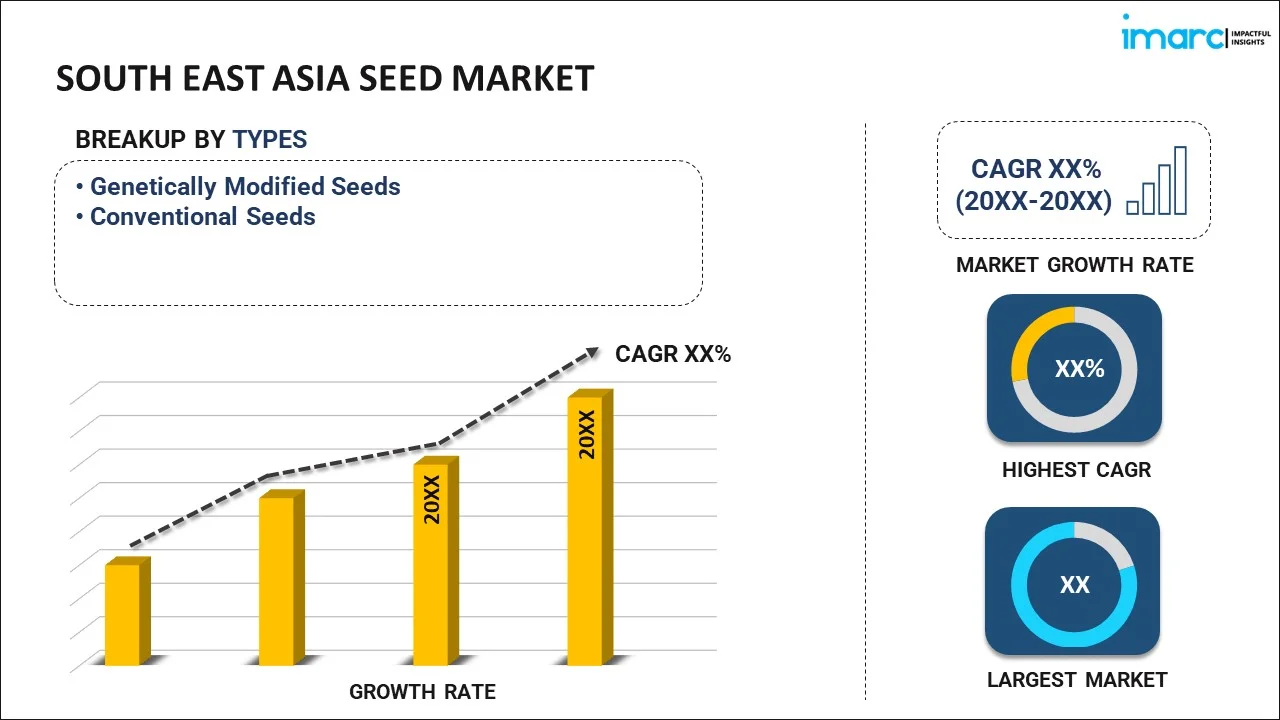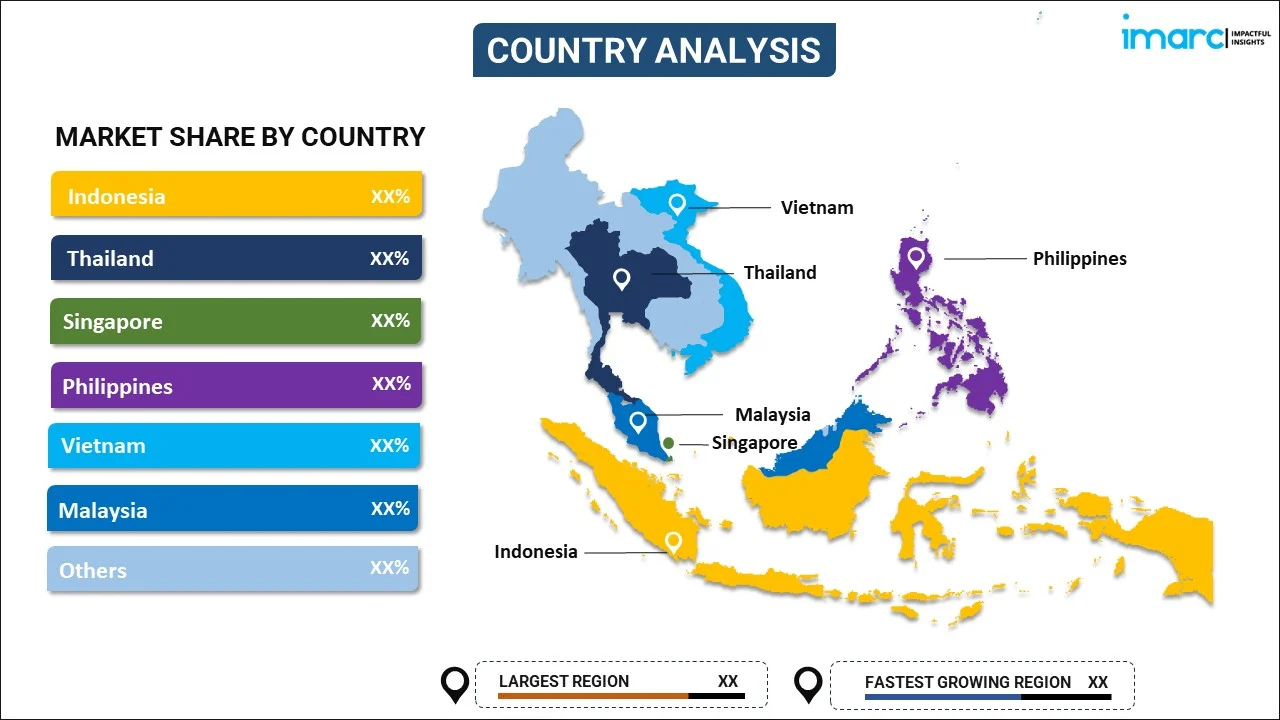
South East Asia Seed Market Report by Type (Genetically Modified Seeds, Conventional Seeds), Seed Type (Oilseeds, Cereals and Grains, Fruits and Vegetables, Burpee and Park, and Others), Traits (Herbicide-Tolerant (HT), Insecticide-Resistant (IR), and Others), Availability (Commercial Seeds, Saved Seeds), Seed Treatment (Treated, Untreated), and Country 2024-2032
Market Overview:
South East Asia seed market size is projected to exhibit a growth rate (CAGR) of 4.47% during 2024-2032. The increasing demand for cloud services and big data analytics, the rising need for more reliable and scalable data processing and storage facilities and stringent regulatory compliance represent some of the key factors driving the market.
|
Report Attribute
|
Key Statistics
|
|---|---|
|
Base Year
|
2023 |
|
Forecast Years
|
2024-2032
|
|
Historical Years
|
2018-2023
|
| Market Growth Rate (2024-2032) | 4.47% |
A seed is a fundamental unit of reproduction and the embryonic stage of a plant encased in a protective outer covering. It serves as the starting point for the growth and development of a new plant. Within a seed, essential genetic information is encapsulated, guiding the formation of roots, stems, leaves, and ultimately, the entire plant. Seeds are crucial for the perpetuation of plant species, enabling them to spread and adapt to diverse environments. They contain stored nutrients to support initial growth until the emerging seedling can sustain itself through photosynthesis. Additionally, seeds exhibit remarkable resilience, often capable of surviving harsh conditions, including drought and extreme temperatures. As a symbol of potential and renewal, seeds have cultural significance and play a vital role in agriculture, horticulture, and ecological systems, contributing to the biodiversity and sustainability of the natural world.
South East Asia Seed Market Trends:
The seed market in South East Asia is driven by several factors that collectively contribute to its dynamic growth. Firstly, an increasing regional population necessitates enhanced food production, compelling farmers to adopt advanced seed technologies for higher yields. Consequently, the growing demand for food security acts as a pivotal driver, urging agricultural communities to invest in genetically modified seeds and precision agriculture. Moreover, climate change poses a significant challenge to traditional farming practices, prompting a shift towards resilient and climate-adaptive seeds. This imperative adaptation to changing environmental conditions further propels the seed market forward. Additionally, advancements in biotechnology and genetic engineering have enabled the development of seeds with enhanced traits such as disease resistance, drought tolerance, and improved nutritional content. These technological strides foster innovation in the seed industry, attracting investments and driving market expansion. Furthermore, the increasing awareness among farmers about the importance of high-quality seeds in maximizing crop productivity plays a crucial role in market growth. Besides this, government initiatives promoting sustainable agriculture and providing subsidies for the adoption of improved seeds are expected to drive the market in South East Asia during the forecast period.
South East Asia Seed Market Segmentation:
IMARC Group provides an analysis of the key trends in each segment of the market, along with forecasts at the regional and country levels for 2024-2032. Our report has categorized the market based on type, seed type, traits, availability, and seed treatment.
Type Insights:

- Genetically Modified Seeds
- Conventional Seeds
The report has provided a detailed breakup and analysis of the market based on the type. This includes genetically modified seeds and conventional seeds.
Seed Type Insights:
- Oilseeds
- Soybean
- Sunflower
- Cotton
- Canola/Rapeseed
- Cereals and Grains
- Corn
- Wheat
- Rice
- Sorghum
- Fruits and Vegetables
- Tomatoes
- Lemons
- Brassica
- Pepper
- Lettuce
- Onion
- Carrot
- Burpee and Park
- Others
A detailed breakup and analysis of the market based on the seed type have also been provided in the report. This includes oilseeds (soybean, sunflower, cotton, and canola/rapeseed), cereals and grains (corn, wheat, rice, and sorghum), fruits and vegetables (tomatoes, lemons, brassica, pepper, lettuce, onion, and carrot), burpee and park, and others.
Traits Insights:
- Herbicide-Tolerant (HT)
- Insecticide-Resistant (IR)
- Others
The report has provided a detailed breakup and analysis of the market based on the traits. This includes herbicide-tolerant (HT), insecticide-resistant (IR), and others.
Availability Insights:
- Commercial Seeds
- Saved Seeds
A detailed breakup and analysis of the market based on the availability have also been provided in the report. This includes commercial seeds and saved seeds.
Seed Treatment Insights:
- Treated
- Untreated
The report has provided a detailed breakup and analysis of the market based on the seed treatment. This includes treated and untreated.
Country Insights:

- Indonesia
- Thailand
- Singapore
- Philippines
- Vietnam
- Malaysia
- Others
The report has also provided a comprehensive analysis of all the major regional markets, which include Indonesia, Thailand, Singapore, Philippines, Vietnam, Malaysia, and Others.
Competitive Landscape:
The market research report has also provided a comprehensive analysis of the competitive landscape in the market. Competitive analysis such as market structure, key player positioning, top winning strategies, competitive dashboard, and company evaluation quadrant has been covered in the report. Also, detailed profiles of all major companies have been provided.
South East Asia Seed Market Report Coverage:
| Report Features | Details |
|---|---|
| Base Year of the Analysis | 2023 |
| Historical Period | 2018-2023 |
| Forecast Period | 2024-2032 |
| Units | US$ Million |
| Scope of the Report | Exploration of Historical and Forecast Trends, Industry Catalysts and Challenges, Segment-Wise Historical and Predictive Market Assessment:
|
| Types Covered | Genetically Modified Seeds, Conventional Seeds |
| Seed Types Covered |
|
| Traits Covered | Herbicide-Tolerant (HT), Insecticide-Resistant (IR), Others |
| Availabilities Covered | Commercial Seeds, Saved Seeds |
| Seed Treatments Covered | Treated, Untreated |
| Countries Covered | Indonesia, Thailand, Singapore, Philippines, Vietnam, Malaysia, Others |
| Customization Scope | 10% Free Customization |
| Report Price and Purchase Option | Single User License: US$ 3699 Five User License: US$ 4699 Corporate License: US$ 5699 |
| Post-Sale Analyst Support | 10-12 Weeks |
| Delivery Format | PDF and Excel through Email (We can also provide the editable version of the report in PPT/Word format on special request) |
Key Questions Answered in This Report:
- How has the South East Asia seed market performed so far and how will it perform in the coming years?
- What has been the impact of COVID-19 on the South East Asia seed market?
- What is the breakup of the South East Asia seed market on the basis of type?
- What is the breakup of the South East Asia seed market on the basis of seed type?
- What is the breakup of the South East Asia seed market on the basis of traits?
- What is the breakup of the South East Asia seed market on the basis of availability?
- What is the breakup of the South East Asia seed market on the basis of seed treatment?
- What are the various stages in the value chain of the South East Asia seed market?
- What are the key driving factors and challenges in the South East Asia seed?
- What is the structure of the South East Asia seed market and who are the key players?
- What is the degree of competition in the South East Asia seed market?
Key Benefits for Stakeholders:
- IMARC’s industry report offers a comprehensive quantitative analysis of various market segments, historical and current market trends, market forecasts, and dynamics of the South East Asia seed market from 2018-2032.
- The research report provides the latest information on the market drivers, challenges, and opportunities in the South East Asia seed market.
- Porter's five forces analysis assist stakeholders in assessing the impact of new entrants, competitive rivalry, supplier power, buyer power, and the threat of substitution. It helps stakeholders to analyze the level of competition within the South East Asia seed industry and its attractiveness.
- A competitive landscape allows stakeholders to understand their competitive environment and provides an insight into the current positions of key players in the market.
Need more help?
- Speak to our experienced analysts for insights on the current market scenarios.
- Include additional segments and countries to customize the report as per your requirement.
- Gain an unparalleled competitive advantage in your domain by understanding how to utilize the report and positively impacting your operations and revenue.
- For further assistance, please connect with our analysts.
 Inquire Before Buying
Inquire Before Buying
 Speak to an Analyst
Speak to an Analyst
 Request Brochure
Request Brochure
 Request Customization
Request Customization




.webp)




.webp)












